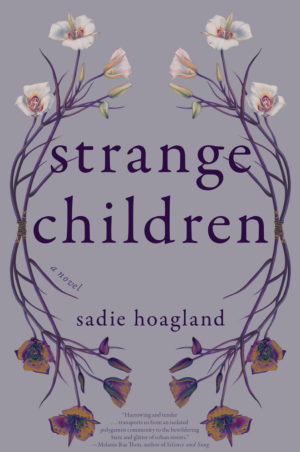Strange Children
by Sadie Hoagland
reviewed by M. Rachel Thomas
In Sadie Hoagland’s debut novel, Strange Children, eight young narrators struggle to navigate two very different worlds. Some are exiled to the lurid, modern American city, with its microwave dinners, senseless violence, and reflexive consumption. Some are confined to the small desert town of Redfield, with its desolate beauty, penny cakes, and simple God-fearing people (that most readers will recognize as polygamist Mormons).
The book has many narrators, but two sit at the center of the unfolding drama: Emma, a pious and spirited girl of twelve, and Jeremiah, a quiet boy of sixteen. The two have a brief romance that leads to his expulsion from the community, and her marriage to his father. The book follows Jeremiah on a harrowing journey through the modern world, and everyone he’s left behind in Redfield as the community begins to lose faith in its leader, “the Prophet.”
There are many things to like about this novel, but prime among them is Hoagland’s lush, lyrical writing, which meanders and crescendos through a series of internal monologues that advance the plot one confession at a time. Consider this extraordinary run-on sentence from Emma’s sister, Annalue, at the end of chapter two:
What I saw is something like scorn come into his face, or maybe even disgust, as he looked at my poor stiffened leg, blue as it is for lack of blood and I saw this look on the face of the Prophet of God and for the first time ever not only did I understand Alice Parley Smith, but I also felt the Devil inside that leg, keeping me from some shame, wanting everything to burn, and for the first time ever I let it rise up toward my heart and let it give me the strength to push myself up from the couch, shake the white underthings off that poor leg, straighten myself and walk out of the Prophet’s house and past Daniel and back down the road where Emma would be watching for me, all with nothing but air under my dress while those white underthings lay still on the floor of the Prophet’s house, left by the Devil and waiting to be picked up by the hand of God.
Unless you’ve already read the book, you don’t yet know who Alice Parley Smith is or what she has to do with Annalue’s crippled leg. You don’t yet know that Daniel is the Prophet’s son or about any of the horrifying things he does. And yet you’ve already learned a great deal about Redfield and the kind of people who inhabit it—people yielding to the conventions of a religious order that deny them agency and autonomy. Conventions they are beginning to reject.
Jeremiah is the only character whose story is told in the third person, as he navigates a horrible home for boys and his relationship with a girl named Haley that will lead to his downfall. “This all looked to him like love. Being in love. Though that whole story was relatively new to him,” Hoagland writes of Jeremiah. “It wasn’t a word people used much back home. Not like ‘I love you,’ and ‘you love,’ but rather God’s love. Always through Him first. But not with Haley. With Haley it was just the two of them and that was the most alright he’d been since he’d left.”
Jeremiah spends the entirety of the novel at arm’s length and eventually recedes into the shadows, even though it is his actions and absence that give the plot its forward momentum—both within Redfield and beyond it. Meanwhile, back in Redfield, Emma gains prominence as the only character whose faith in—and relationship with—the Prophet grows, spinning the narrative in a new and unexpected direction.
Hoagland doesn’t spare us the horrors of Redfield or of the city (although, those of the world we know appear in starker contrast as her protagonists wrestle with and succumb to them). The tragedy of Hoagland’s “strange children” is one of displacement: the Prophet is faltering; the outer world is encroaching; their community is unraveling; and our young protagonists, both within the community and expelled from it, are abandoned and disoriented.
If the point of fiction is to transport us somewhere unknown, Hoagland delivers in spades, and in prose that is consistently evocative, compassionate, and surprising. For most of us, this revelation will include not just Redfield where most of the story takes place, but also the kind of parched, unremarkable Utah city we pass en route to somewhere else. The revelation will also include the inner minds of these teens, each looking for some form of deliverance, each struggling to land a foot on solid ground.
Published on February 11, 2022

